If I only had room for one Sweet Tart Crust recipe in my life, this would be it. Called Pâte Sucrée in French, it’s an excellent master pastry for all sweet tarts. Buttery and not too sweet, flaky but not so crumbly that makes it difficult to eat with a fork. Plus, the dough is extremely easy to work with – easier than Shortcrust Pastry.
This is the pastry crust I used in the Pistachio Pear Tart recipe I also shared today!
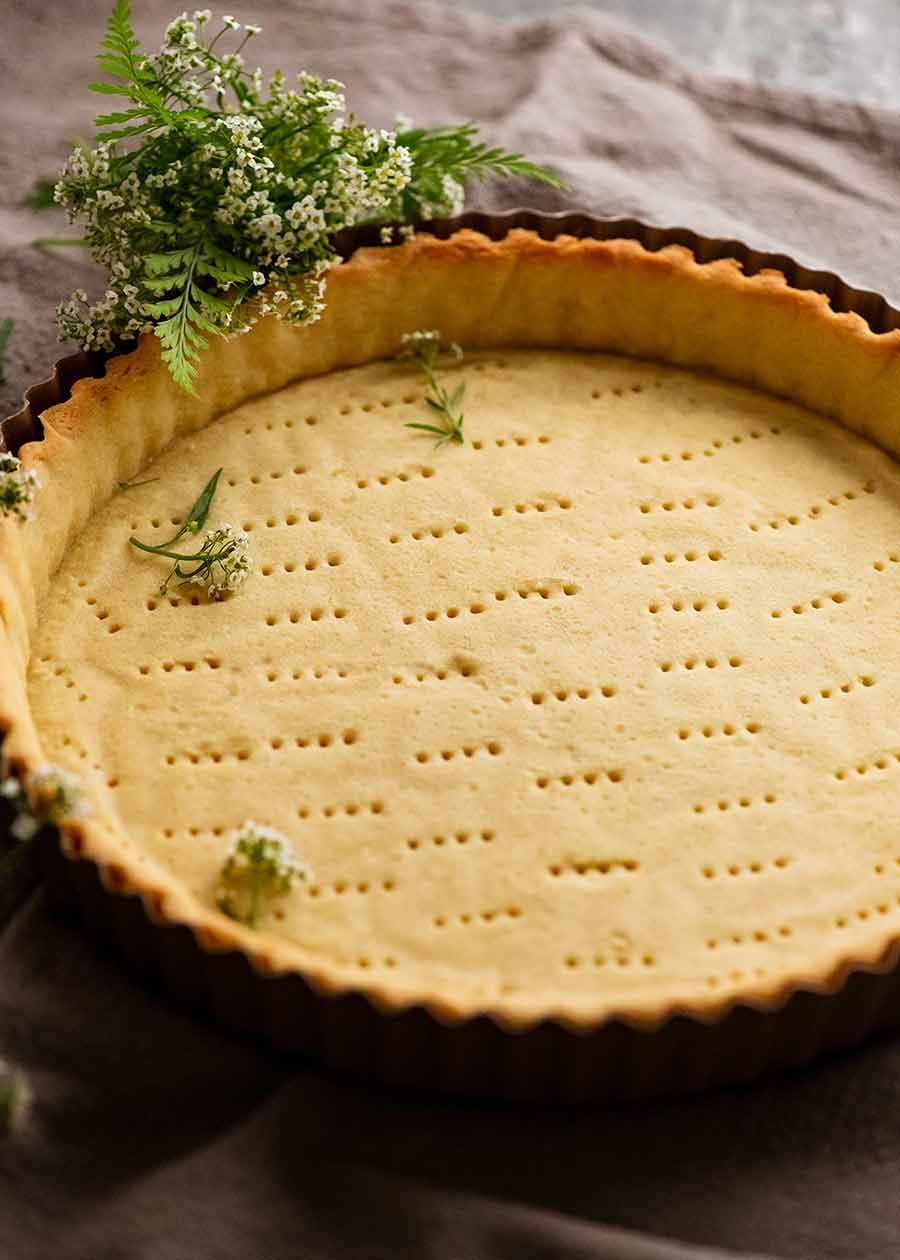
About this Sweet Tart Crust (sweet pastry recipe)
This is a recipe for a classic French Sweet Tart Crust that is suitable to use for tarts, large or small, or for sweet pies. It can be cooked in a tart tin, as demonstrated in this post, or in pie tins.
You’ll love how the dough is easier to work with than traditional shortcrust pastry. It’s less crumbly, more pliable and less prone to tearing. And you’ll love how the crust is not quite as crumbly and flaky as shortcrust pastry so it’s easier to eat with a fork, rather than disintegrating into crumbs.
It’s still however beautifully buttery – it is French after all, so we would expect nothing less! – yet without being excessively sweet.
As for its utility, it makes a tart shell that is crispy so the base won’t go soggy once filled. It’s suitable for no-cook fillings (like Chocolate Ganache) or cooked fillings (ie. where the tart is filled then baked again, like Pistachio Pear Tart and the Chocolate Tart pictured below).
In short, it’s a master recipe worth, well, mastering – I promise it will serve you well for the rest of your life!!
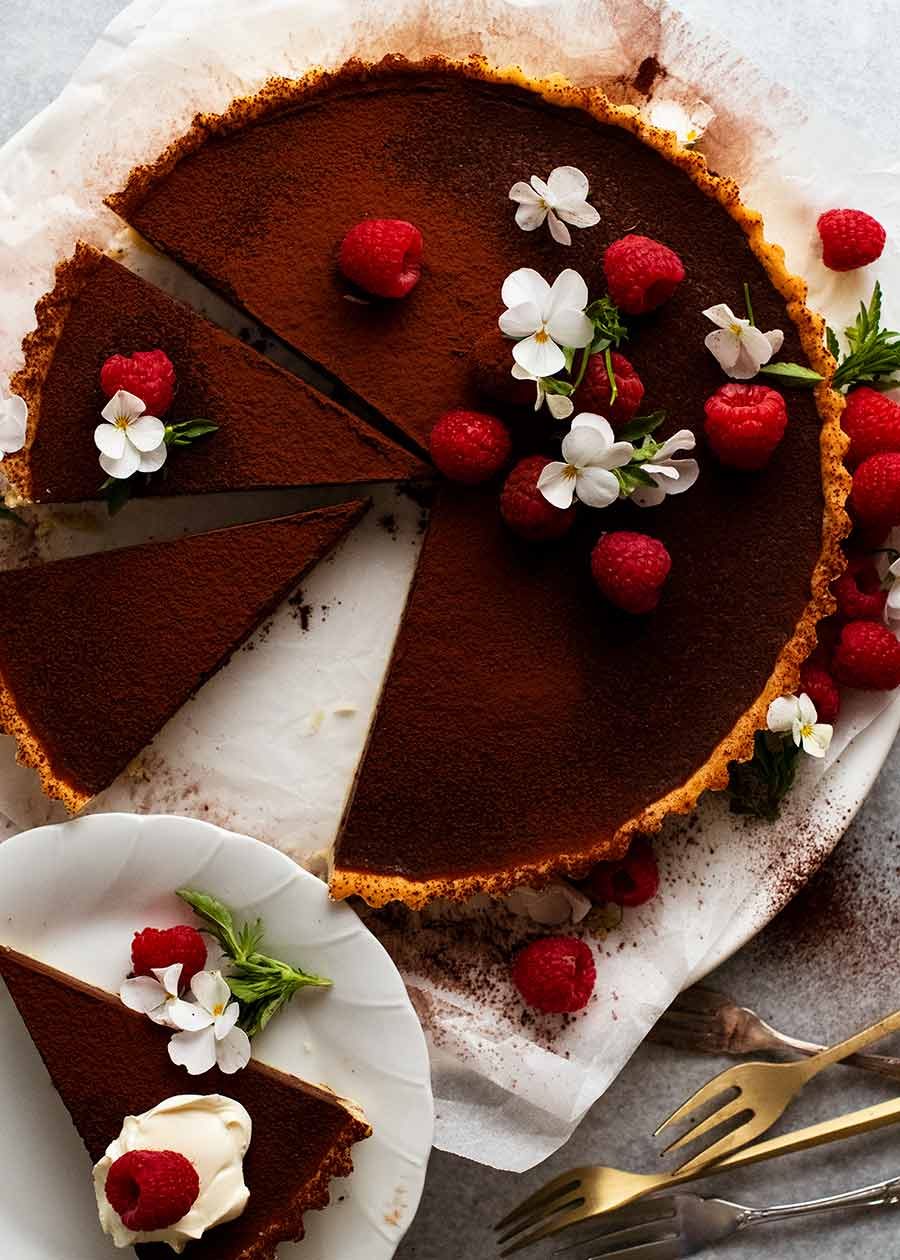
What goes in this Sweet Tart Crust
Here’s what you need to make this tart pastry:
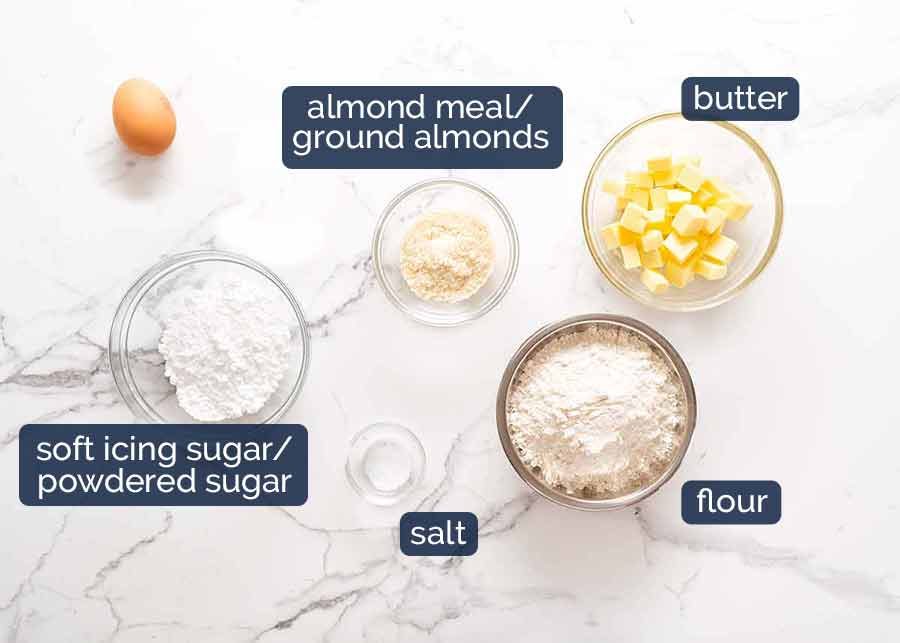
Flour – Just plain / all purpose flour;
Icing sugar / powdered sugar – The finer, powder-like grains make this incorporate more thoroughly and easily into the dough compared to ordinary white sugar grains;
Almond meal / ground almonds – Not to be confused with almond flour which are finer grains, this adds a touch of nuttiness that complement sweet fillings as well as adding a hint of moistness to the pastry; and
Butter – Ain’t no French pastry if it doesn’t contain plenty of butter! 😂
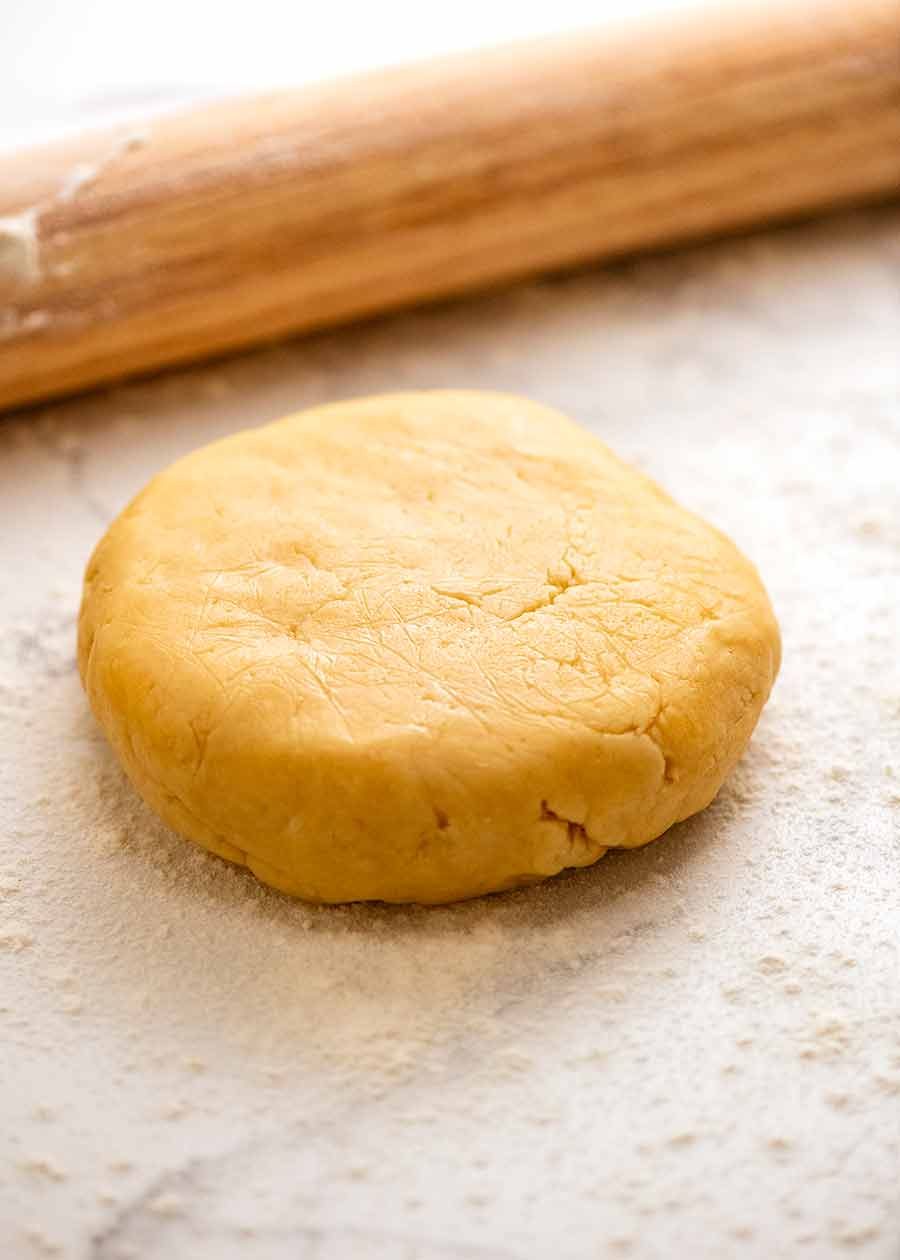
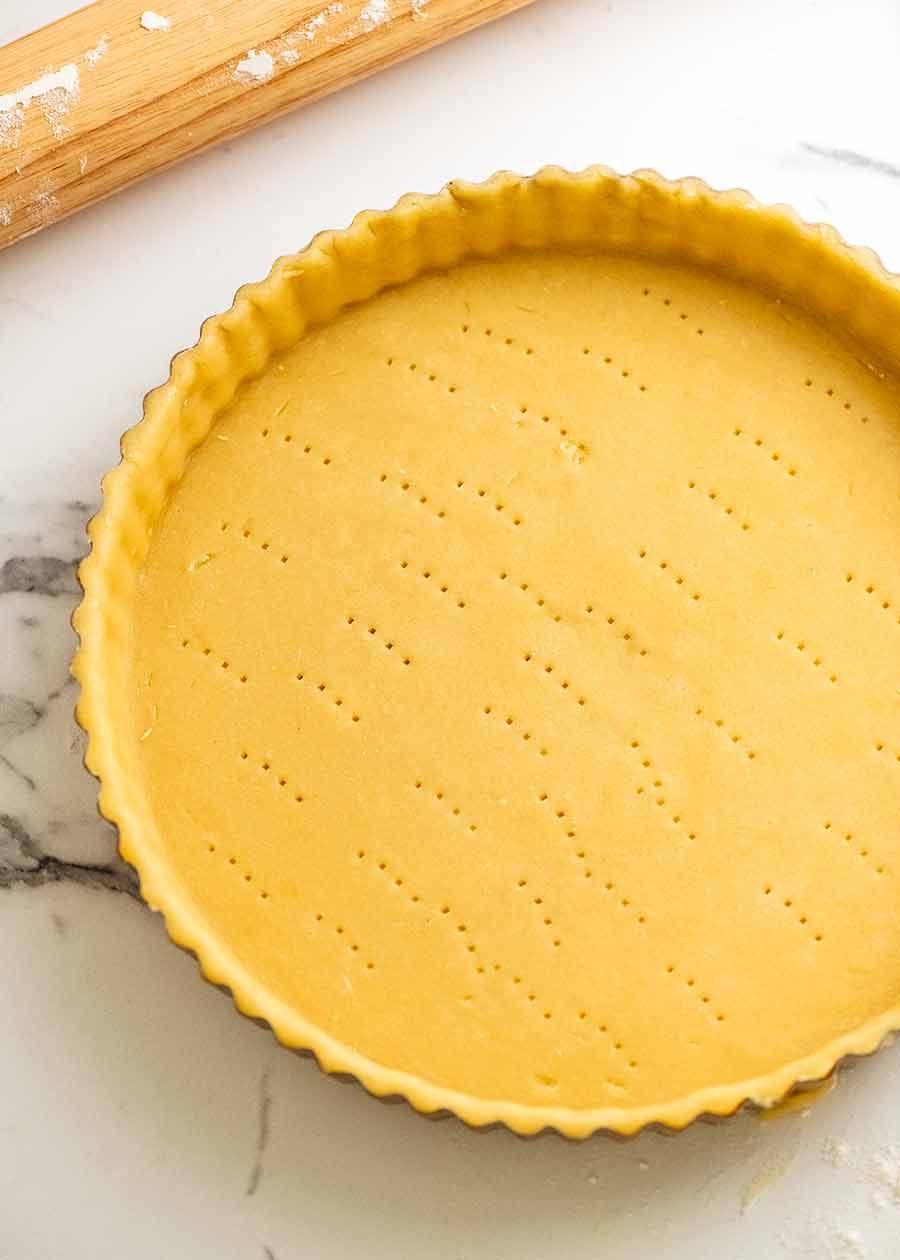
How to make Sweet Tart Pastry
1. The tart pastry dough
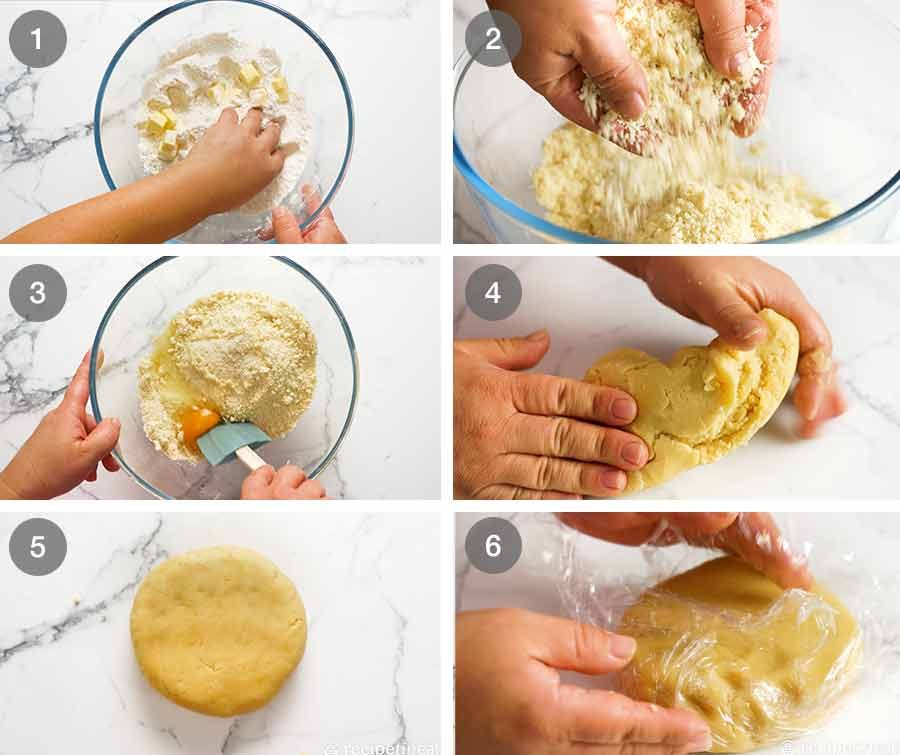
Mix the flour, icing sugar, almond meal and salt, then use your fingers to rub the butter in until it resembles breadcrumbs;
The mixture should be a bit like wet sand that can run through your fingers;
Add egg and mix through with a rubber spatula until the mixture stiffens to the point you can’t really mix any more;
Now turn the dough out onto a work surface and use your hands to bring it together into a dough. You don’t need to knead it, just bring it together into a smooth ball;
Shape the dough into a ball then pat it down into a 2.5cm / 1″ disc; and
Wrap with cling wrap, and refrigerate for 30 minutes or even overnight.
2. Rolling out the pastry
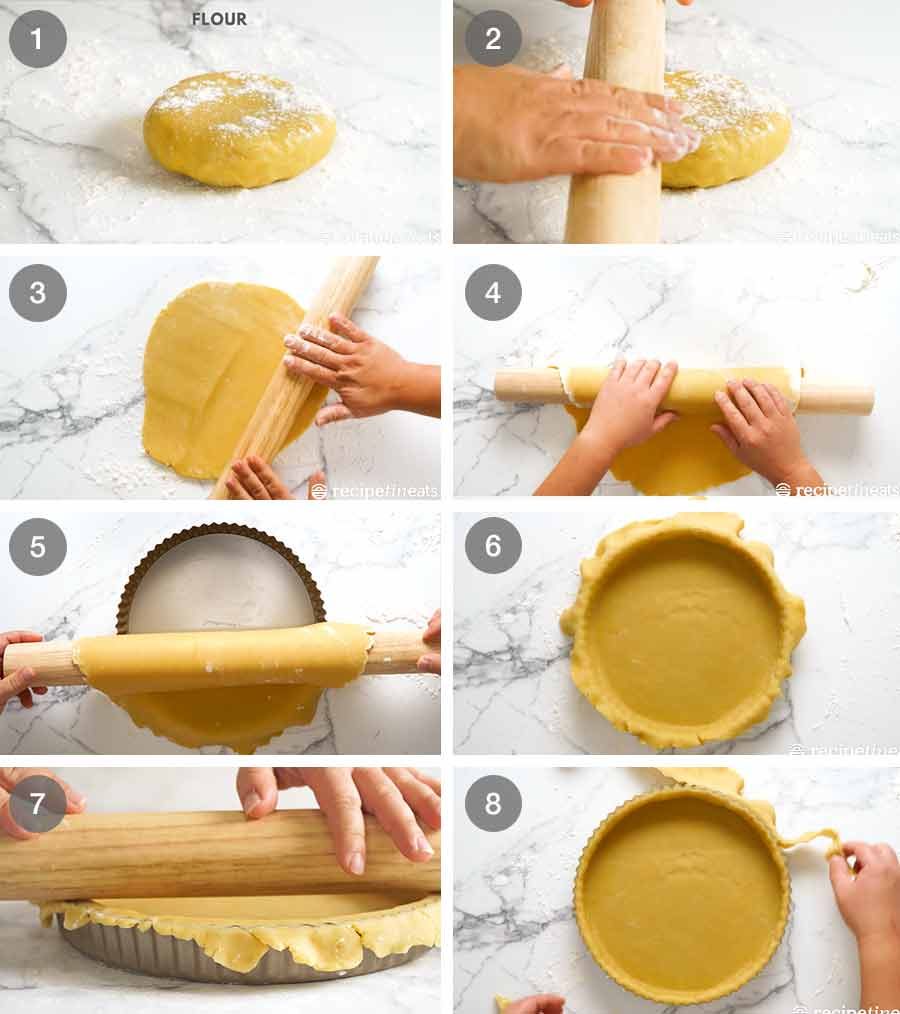
Remove the dough from the fridge and unwrap. Note: If you refrigerated overnight or much longer than 30 minutes and the pastry is rock solid, leave it out for a bit until it softens enough that it can be rolled out;
Place the dough on a lightly-floured work surface, then sprinkle the dough surface lightly with flour;
Roll out into a 32cm / 13″ round, 3mm / 1/8″ thick;
To transfer the pastry into the tart tin, roll the pastry onto the rolling pin, taking care not to stretch the pastry. Stretching the pastry causes shrinkage when it bakes;
Gently unroll the pastry over the tart tin;
Use your fingers to drape it in and gently coax it into the corners to fill the tart tin, as opposed to pulling or stretching it. As noted above, if you stretch the pastry, it will shrink back as it bakes;
Drape the excess pastry outside the rim of the tart tin, then roll the rolling pin across the surface to cut the excess off; and
Remove excess pastry (but keep it, in case there’s a patching-up emergency to tend to later!)
3. Baking
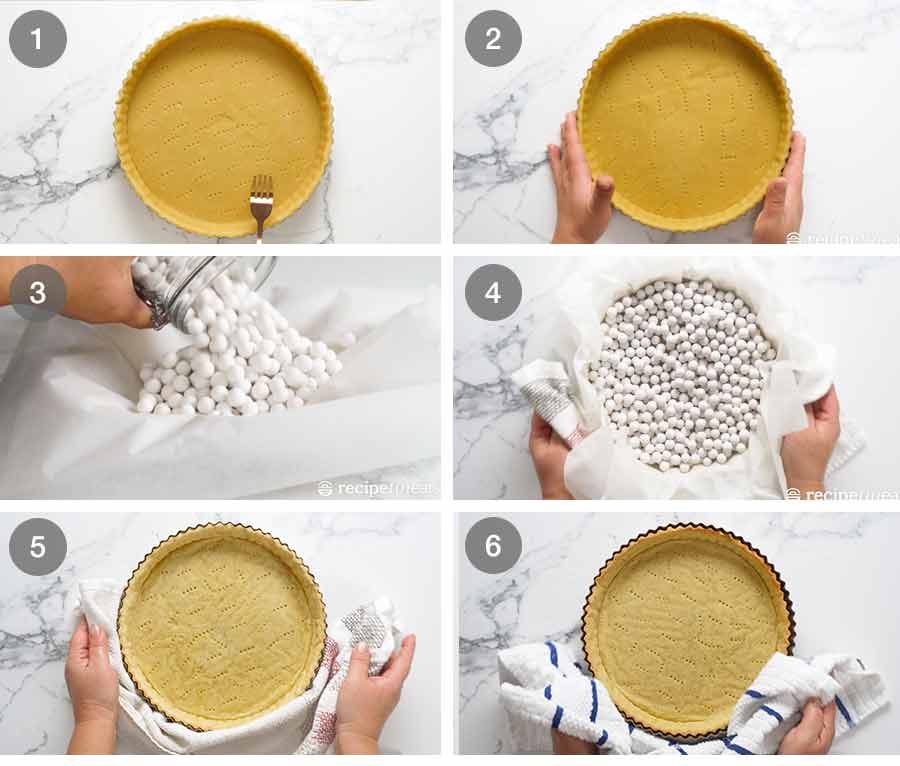
Prick base – Prick the base with a fork. This allows steam to escape which stops the base from puffing up, so you have a nice smooth and not a bubbled base;
Fridge for 30 minutes – Refrigerate for 30 minutes.
Prepare blind baking – Cover the pastry with 2 large sheets of baking / parchment paper one on top of the other in a short “X”, then fill with baking beads to weigh it down. The purpose of these weights is to prevent the base from puffing up and the sides from collapsing inwards during this blind baking stage.
Don’t have baking beads? Use 2 cups dried rice or dried beans instead;
Blind bake: Bake at 200°C/390°F (180°C fan) for:
• 15 minutes (Par Baked Crust) – if the tart, once filled, will be baked for more than 30 minutes; or
• 20 minutes (Fully Baked Crust) – if you are making a no-bake tart (ie. no baking once filled) or a tart that is baked 25 minutes or less once filled;Remove beads CAREFULLY! Remove crust from oven, then remove the beads. Lift them out using the paper overhang and put them in a bowl. Be careful here – nobody wants to pick up hot beads scattered all over the kitchen floor!
Bake uncovered – Return the uncovered tart crust to the oven and bake for a further:
• 5 minutes (Par Baked Crust) – if the tart, once filled, will be baked for more than 30 minutes; or
• 10 minutes (Fully Baked Crust) – if you are making a no-bake tart or a tart that is baked 25 minutes or less once filled;
Fully cool before filling – this will ensure the base stays nice and crispy rather than going soggy.
Why the different baking times? Par Baked vs Fully Baked Tart Crust.
If the tart will be baked for more than 30 minutes once filled, then the pastry will finish cooking through during this time. In this case, we just make a Par Baked Crust ie cooked enough so the surface is crisp and protect base from going soggy, but inside of base is slightly undercooked. This way, the tart crust will not be dry and overcooked once the filling is cooked.
However, if you’re making a tart with a filling that doesn’t require baking OR the bake time once filled is very short (25 minutes or less), then we need to fully cook the shell through before filling. So use the Fully Baked Crust bake times.
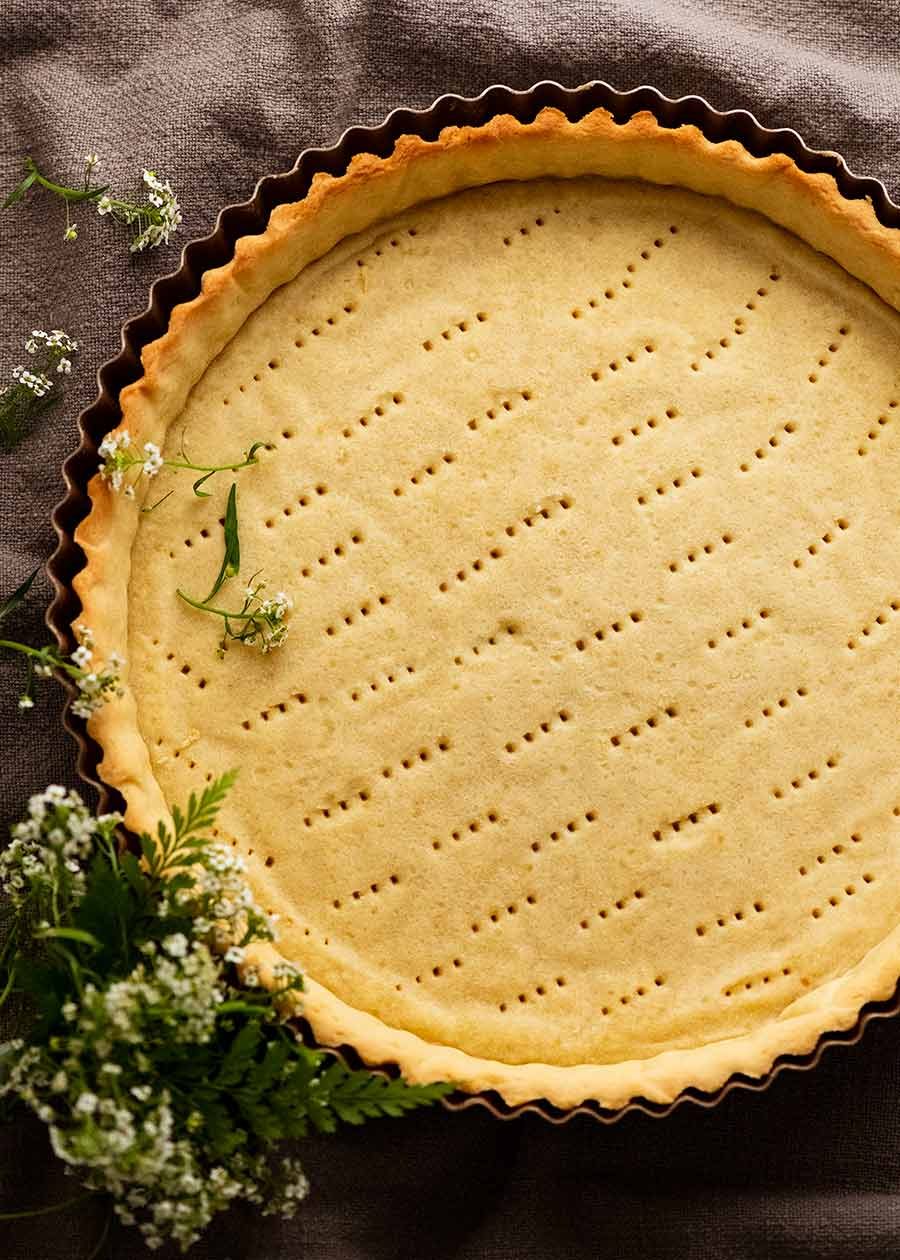
How to use this pastry crust
This pastry shell can be used for baked or no-bake fillings. The shell is cooked enough so it is crispy on the outside, but slightly undercooked on the inside, and the surface is light golden. This is so once it’s filled and then baked again (anything up to around 45 minutes), the pastry will finish cooking through and the edges will be a lovely golden colour rather than burnt, as shown in the Pistachio Pear Tart pictured below.
If using for a no-bake filling (for example, if filling with Creme Patissiere) or a filling that requires less than 25 minutes of bake time (like a Chocolate Tart that I will be sharing soon that bakes for 25 minutes at a low temperature), then the bake time needs to be increased by 10 minutes to fully cook the pastry through.
The pastry shell can be made up to 3 days ahead and stored in an airtight container in the pantry.
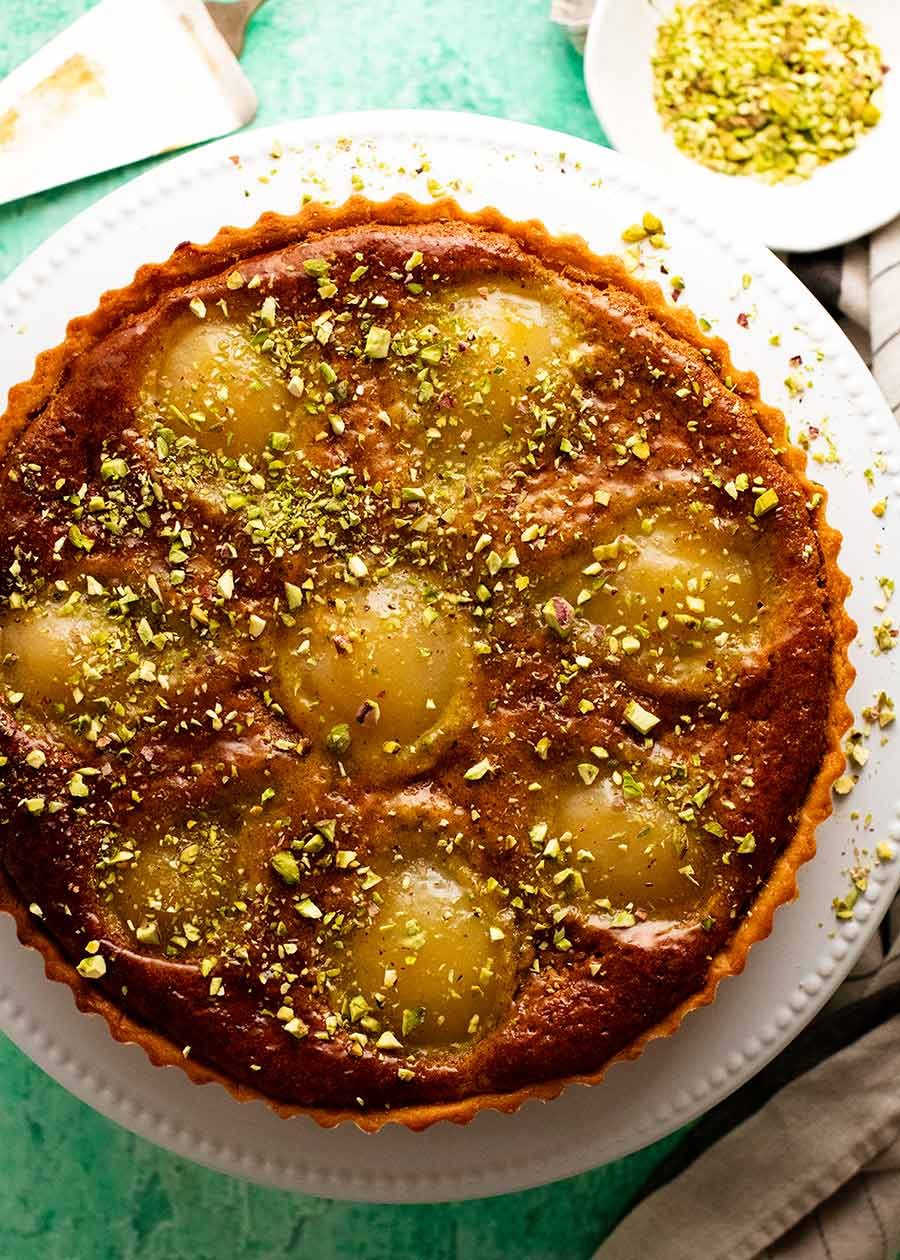
Fillings for Tarts
I wish I had a library of tart recipes I could share with you to fill this tart shell with! But I’m just starting out on my tart collection journey, so I’m a bit lacking. However, here are some ideas:
Pistachio Pear Tart – the tart recipe I shared today that I used this tart crust for. With a Pistachio Frangipane Filling topped with soft Vanilla Poached Pears, this is a smart yet rustically casual tart fitting for all occasions!
Salted Caramel Tart – use the filling from my Salted Caramel Tart recipe (which uses a biscuit base, just fill this pastry shell instead);
Peanut Butter Caramel Tart – use the filling from my Peanut Butter Caramel Tart recipe;
Pecan Tart – use the filling from my Pecan Pie;
Chocolate Custard Tart – use the filling from my Chocolate Cream Pie;
Lemon Tart – I use the lemon filling from this Lemon Tart recipe by David Lebovitz. I find it a bit too tart – as in sour, hah – as written (and I don’t even have a sweet tooth!). So I reduce the lemon juice to 3/4 cup and increase the sugar to 1 cup;
Lemon Meringue Tart – Top the above Lemon Tart with Italian Meringue. I use this recipe. It involves hot sugar syrup slowly drizzled in while beating the meringue. You can’t just use ordinary whipped egg whites with sugar as it will weep / sweat; and
Custard Fruit Tart – I haven’t published this yet, but here is a PDF of the recipe!
So many more possibilities … but that’s a few to get you inspired! – Nagi x
Watch how to make it
Hungry for more? Subscribe to my newsletter and follow along on Facebook, Pinterest and Instagram for all of the latest updates.
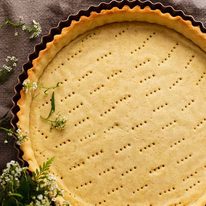
Pâte Sucrée – French Sweet Tart Crust (pastry dough)
Ingredients
- 1 1/2 cups flour , plain/all purpose
- 6 1/2 tbsp soft icing sugar / powdered sugar , sifted (Note 1)
- 2 1/2 tbsp almond meal / ground almonds (Note 2)
- 1/4 tsp salt
- 100g / 7 tbsp butter , unsalted, softened, cut into 1cm cubes
- 1 large egg , at room temperature (55-60g/2 oz) (Note 3)
Instructions
Tart dough:
- Mix Dy Ingredients: Whisk together flour, icing sugar, salt and almond meal in a bowl.
- Add butter: Use your fingertips to rub the butter into the dry ingredients until it resembles breadcrumbs. (Note 4).
- Add egg: Mix with a rubber spatula until it becomes too hard to stir anymore, then use your hands to bring it together into a dough.
- Bring dough together: Turn dough out onto a work surface, then knead to bring together into a smooth ball. Flatten into a 2cm / 0.8" thick disc. Wrap with cling wrap and refrigerate for 30 minutes.
Rolling out:
- Unwrap chilled dough. Place on a lightly floured work surface.
- Roll out into a 32cm / 13″ round (3mm / 1/8″ thick).
Line tart tin:
- Line tart tin: Roll pastry lightly on to a rolling pin (ie. so it wraps around itself). Then unroll it gently over the tart tin.
- Fit pastry: Adjust the pastry to fit into the tart tin, fitting into the corner, taking care not to stretch it (causes shrinkage during bake).
- Trim excess dough: Roll the rolling pin over tart tin to trim excess dough. Pictured tart tin is 24 x 3 cm / 9.5 x 1.2" – you can use any up to this size.
- Prick the base of the pastry 30 times with a fork. Not all the way through – just make a light prick on the surface.
- Chill pastry in tart tin for 30 minutes.
Baking:
- Preheat oven to 200°C / 390°F (180°C fan).
- Baking beads: Cover pastry with 2 sheets of baking paper (parchment paper), in a "X" arrangement. Fill with baking beads (or 2 cups dry raw rice or beans).
Par Baked Tart Crust:
- Baking times for a Par Baked Tart to be used for tarts that are baked for > 30 minutes once the filling is added into the cooked tart shell.
- Bake 15 minutes the remove from oven. Use excess paper to remove baking beads.
- Bake uncovered 5 minutes: Return tart crust to oven for 5 minutes. Pastry should be light golden, crispy on surface, but slighty undercooked inside (will finish cooking once filled and baked again).
Fully Cooked Tart Crust:
- Use these baking times if the tart shell is to be used for raw fillings (ie tart not baked once crust is filled) OR fillings that are baked for < 25 minutes.
- Bake 15 minutes the remove from oven. Use excess paper to remove baking beads.
- Bake uncovered 10 minutes: This will fully cook the pastry through and give it nice colour which we need as the pastry won't cook through in less than 25 minutes once filled.
Cool & use
- Cool: Remove then cool in tart tin before filling (this ensures crust stays crispy once filled), then baking again if filling needs to be cooked (like this Pistachio Frangipane Pear Tart).
- Make ahead up to 3 days, suitable for baking once filled.
Recipe Notes:
Nutrition Information:
Life of Dozer
Dozer vs Nagi in the battle of the doughnut. Who won??

You mention using the soft icing sugar instead of pure, can I ask why? I tend to prefer using the pure icing sugar for my recipes so don’t have any soft in the house and given the lockdown, I’d rather not go to the shop just for soft sugar. Thanks
Hi Ella! Soft icing sugar has cornflour in it too and it makes the crust a bit softer. Pure icing sugar will work but it’s like using normal sugar in it, it will make the base a wee bit crisper than is “traditional” but it is still wonderful. I would use pure icing sugar in a flash if that’s all I had 🙂 N x
Hi Nagi, thank you for the recipe. I made it but the dough became soggy and started to break apart. It did not stiffen even when using the rubber spatula. What do you think went wrong. I live in a hot climate, could that be a cause?
Hi there! I also live in a hot climate and this pastry is so rich that it easily breaks down in heat. I find that it’s easier to work with if I keep popping it back in the fridge for 5-10 mins and I also rest ice cubes or frozen peas on the counter top for 10 mins I use to roll it out so it copes better. A baker friend of mine puts all of her equipment and the flour in the fridge to compensate for the heat and her pastry shells are crazy good
I would like to make 4 individual tarts instead of one large tart. Would the cooking time be the same ?
Hi, may I know if I can freeze and store the unbaked tart shells?
Yes 100% Caroline! N x
Hi Nagi,
Can you use an alternative to almond meal? E.g., regular flour or oat flour. Do you have to make adjustments to do this?
Thanks!
Hi Cait, try this recipe here: https://salesdock.info/pie-crust-recipe/%3C/a%3E N x
This looks great, I love the idea of almond meal in the dough. Can’t wait to make it! Can i ask what brand of parchment paper you use to blind bake this? I must say I normally hate blind baking because parchment paper folds and creates all these dents in the tart shell. But your parchment paper looks much softer than mine so I’d love to try that.
Hi Jane! I’m in Australia and I use Glad 🙂 N x
do I grease the tin before adding pastry??
Hi Helen, no I don’t bother here! N x
Hi Nagi. I’m curious – you use softened butter in your pastry recipe. I’m used to using very cold butter for pastry. What’s the difference?
Hi Rebecca, this is a GREAT question! The answer put simply is to do with the final texture, using cold butter yields a flakier pastry, using softened blends better with the flour proteins, preventing them from sticking together and yields a more tender crust. Both ways work and both ways are great, it simply depends on what you’re making and what type of crust you want to achieve. I hope this helps!! N x
Ahh the wonderful science of cooking. I just use all these different techniques without understanding the “why”behind it – it’s fascinating 🙂
Sounds like fantastic recipe can I omit the almond meal and add as flour instead. As I allergic to nuts. Or should I add something else?
Hi Nagi, I loved the lemon tart, but just had a hiccup with the pastry. I used the thermo dough function and then cooked 10 minutes at 180 after blind bake. Had trouble cutting pastry even with a knife. What have I done wrong?
Hi Joanne, I can’t quite be sure as I’m not familiar with the thermo dough function and what this does to the dough sorry! N x
Hi Joanne, I use a Thermomix too. I think that the problem may be that you used the dough setting which would have severely overworked it because it goes for about 4 minutes. For my pastry I just do 20- 25 seconds on speed 6. It comes out perfect every time.
I hate making pastry but this was so easy. Thank you. Is there a savoury version just as easy
First time ever I have nailed a sweet pastry recipe & turned out perfectly with the lemon filling
Thanks Nagi !
WOOT!!! That’s the best Toni! N x
Absolutely fabulous, I had the wrong butter and icing sugar and it still turned out amazing , I did need to use about an extra half cup of flour when rolling out , but still fabulous,
Why not use weight measurements? Just use the metric?
Hi Cindy, click the metric toggle above the ingredients. It will list everything in grams and mls for you. N x
I am curious why the dry ingredients are not listed by weight. In baking I usually use my scale for accurate measurements. Just wondering.
I am curious why the dry ingredients are not listed by weight. In baking I usually use my scale for accurate measurements. Just wondering.
I’m in the process of making this dough for the lemon tart.
Lazy girl question here Nagi – would it be okay to make this using a food processor?
Hi Dara – note 4 😉 N x
Do you use blanched almonds or almonds with the skin on?
Hi Leanne – You buy almond meal / ground almonds already in this form. Usually it’s made from skinless almonds. – Nxx
I’ll give this a try for a special occasion coming up, with your lemon tart filling! I’m sorry if this is a silly question, but how do you remove the tart crust from the tin? Is the best way to turn the tin upside down over a flat plate? I’m worried it will crumble when I try to ease it out.
Can the tart be made without the almonds?
I can’t see what size pie dish you have used for this recipe. Can you advise please? I am hoping to make it soon as it sounds to die for.
Thanks for your wonderful recipes and lovely clear instructions.